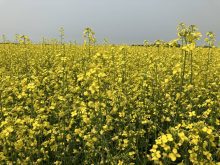Agriculture has undergone big changes in the last century. Yesterday’s farmers would be amazed by the technology contained in a tractor and seeder these days, or by the vaccines that protect livestock from disease. Or even by the phones we tuck into our back pockets, and occasionally drop in the muck.
It’s an interesting exercise to think about what agriculture might look like in 20 years. Here are two agronomic problems that I think may change how people grow crops.
1. Clubroot
Once considered a disease of Alberta canola, these spores have been found in every Prairie province. Clubroot infestations can be managed in the early stages of the disease, but if left unchecked, spore loads can grow too high to grow canola in an infested field. Genetic resistance in varieties has been breached in heavily-infested fields, underlining the fact that there is no silver bullet for this soil-dweller.
Read Also

Cancer agency reclassifies another herbicide ‘probably carcinogenic’
The WHO’s cancer research agency has now put atrazine, a herbicide well known to corn growers, in the same potential-hazard category where the agency put glyphosate.
Canola acreage shows no sign of dropping, at least not this year. But at some point, farmers are going to need to give their rotations a break from the oilseed to manage the disease. Yet canola remains one of the few economical cropping options for many regions on the Prairies.
I think this change will be relatively gradual. Perhaps clubroot will push industry and government to develop and champion crops that are a profitable alternative to canola. Already we’re seeing soybeans push north. Pasta makers are incorporating faba beans into their products. Maybe quinoa will be the next Cinderella crop. Or maybe it will be a combination of several new crops that slowly gain acres.
Clubroot is not the only canola disease exacerbated by tight rotations. Eventually those disease pressures will tip the economics towards less canola in the rotation. I don’t think canola will vanish from our landscape, but I think we will see fewer of those striking yellow fields in the long term.

2. Herbicide resistance
There’s no denying that herbicide resistance is growing in Western Canada. Chemical companies are encouraging farmers to use at least two active ingredients on weeds by mixing and repackaging existing products. But they haven’t come out with new chemistry in years, and anyone I’ve talked to says there’s nothing new in the pipeline.
Meanwhile, herbicide resistance management plans can be complex, and extra costs may not pay off in the short term. In the fall of 2016, Kate Sanford Mitchell of Bayer passed on a sensible piece of advice to avoid being overwhelmed.
“Pick one management technique that you can do on at least one field. Try it out. See if it works on your farm,” she said. I can see farmers doing this very thing, gradually adding new tools to their tool belts. I bet many readers are doing it already.
Harvest weed seed destruction looks promising for some weeds, and strategic tillage may knock back others. Higher seeding rates, winter crops, perennials, cover crops, inter-crops, longer rotations, and more competitive varieties help. So does controlling weeds in ditches.
I think farmers will still be using herbicides in 20 years. But I think they’ll also be relying on more tools to manage weeds than they do today. Here’s what a typical farmer might do in the future:
- Till weedy patches in a couple of fields.
- Seed a marginal (and unprofitable) patch to grass to control weeds.
- Seed cover crops in a third field.
- Use herbicides throughout the farm, but tank mix everything.
- At harvest time, destroy some of the weed seeds through an attachment on the combine.
These are just a couple of agronomic problems that I think will drive change on farms. There are many problems and advances that will contribute to change. My guess is that farming will become more management-intensive and complex. Farmers retiring today will be amazed by what our future farmers can do.
















